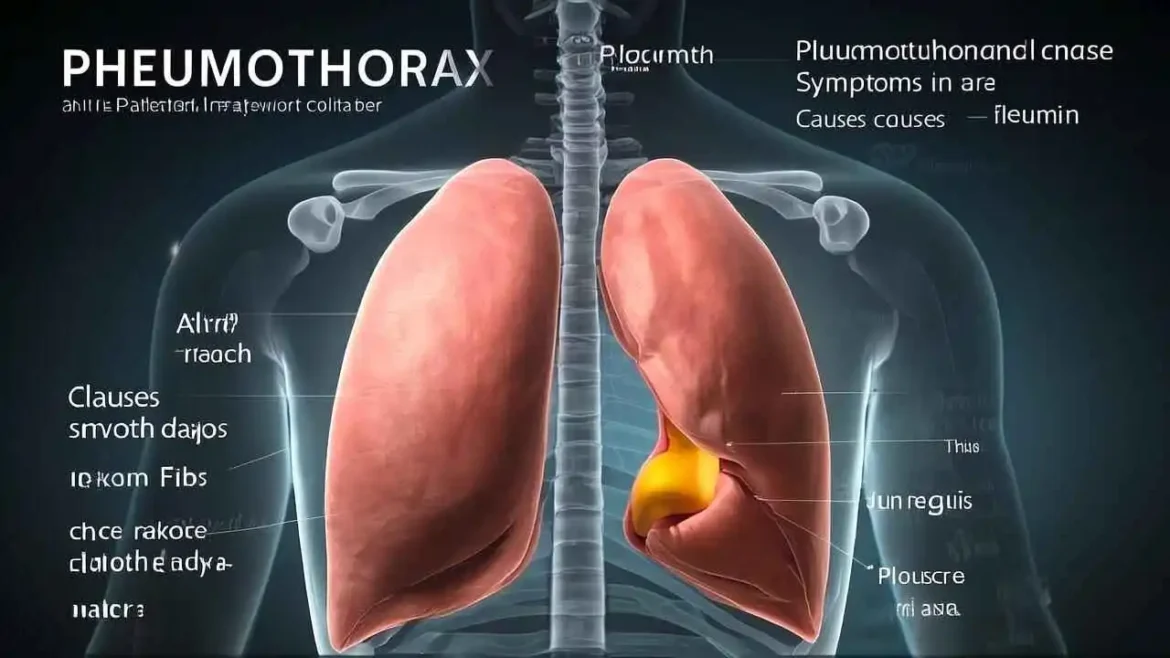
What Is a Collapsed Lung? Understanding Pneumothorax Symptoms & Causes
Of all the automatic processes our bodies perform, none is more fundamental than breathing. It’s a rhythmic, life-sustaining act we often take for granted—until it’s compromised. One of the most sudden and alarming conditions that can disrupt this vital function is a pneumothorax, more commonly known as a collapsed lung. To understand this condition, we must first dive into the intricate mechanics of our own chests.
In this article, we will explore the nature of a pneumothorax, demystifying its causes, identifying its symptoms, and outlining the modern medical treatments available to restore the simple, essential act of breathing.
The Delicate Balance Within: What is a Pneumothorax?
Imagine your lungs as two balloons housed inside a sealed, rigid container—your chest cavity. Between the outside of each “balloon” (the lung) and the inside of the “container” (the chest wall) is a very thin, fluid-filled area called the pleural space. Normally, this space contains a slight vacuum, or negative pressure, which acts like a gentle suction, keeping the lungs pulled outward and fully inflated as we breathe.
A pneumothorax occurs when air leaks into this pleural space. This breach disrupts the negative pressure, breaking the seal that holds the lung against the chest wall. Without that suction, the lung’s natural elasticity causes it to pull inward and collapse, much like a balloon deflating. The degree of collapse can range from a small, partial deflation to a complete collapse, severely limiting the lung’s ability to exchange oxygen and carbon dioxide.
As the renowned pulmonologist Dr. John Heaton remarked, “The pleural space is a potential space, a delicate balance of pressures. When that balance is broken, the body sends a clear, if painful, signal that something is fundamentally wrong.”
Why Does It Happen? Causes and Types of Pneumothorax
A pneumothorax isn’t a one-size-fits-all condition. The cause of the air leak determines its type, which in turn influences the treatment approach. We generally categorize them into three main groups: spontaneous, traumatic, and tension pneumothorax.
1. Spontaneous Pneumothorax
As the name suggests, this type occurs without any obvious external injury. It is further divided into two sub-types:
- Primary Spontaneous Pneumothorax (PSP): This happens in individuals with no known underlying lung disease. It is most often caused by the rupture of tiny, blister-like air sacs on the surface of the lung called blebs or bullae. While the exact cause of these blebs is unknown, certain risk factors are well-established. It most commonly affects tall, thin males between the ages of 20 and 40, and smoking dramatically increases the risk.
- Secondary Spontaneous Pneumothorax (SSP): This type develops as a complication of a pre-existing lung condition. Diseases that weaken the lung structure make it more susceptible to rupture. Common associated conditions include Chronic Obstructive Pulmonary Disease (COPD), asthma, cystic fibrosis, pneumonia, lung cancer, and tuberculosis. SSP is generally more serious than PSP because the individual’s underlying lung function is already compromised.
2. Traumatic Pneumothorax
This type results from a direct or indirect injury to the chest.
- Penetrating Injury: A wound from a knife, gunshot, or other sharp object can pierce the chest wall and lung, allowing air to enter the pleural space from the outside.
- Blunt Force Trauma: A hard impact from a car accident, a significant fall, or a sports injury can fracture ribs. The sharp, broken end of a rib can then puncture the lung tissue.
- Iatrogenic Pneumothorax: This is an inadvertent complication of a medical procedure. Operations like lung biopsies, the insertion of central venous lines, or mechanical ventilation can sometimes accidentally puncture the lung.
3. Tension Pneumothorax
This is the most severe and life-threatening form of pneumothorax. It occurs when the injury creates a one-way valve effect—air can enter the pleural space during inhalation but cannot escape during exhalation. As a result, pressure builds rapidly inside the chest cavity. This escalating pressure not only completely collapses the affected lung but can also push the heart, trachea, and major blood vessels to the other side of the chest (a phenomenon called mediastinal shift). This shift can impede blood flow back to the heart, leading to a rapid drop in blood pressure, shock, and potentially cardiac arrest. A tension pneumothorax is a medical emergency requiring immediate intervention.
| Type of Pneumothorax | Common Causes | Typical Patient Profile |
| Primary Spontaneous | Rupture of small air blisters (blebs or bullae). | Tall, thin males aged 20-40; smokers. |
| Secondary Spontaneous | Complication of underlying lung disease (e.g., COPD, asthma, cystic fibrosis). | Individuals with a history of chronic lung conditions. |
| Traumatic | Penetrating injury (stab wound), blunt force trauma (car accident, broken ribs), or medical procedures (iatrogenic). | Anyone who has sustained a chest injury or undergone certain medical interventions. |
Recognizing the Warning Signs: Symptoms to Watch For
The symptoms of a pneumothorax can appear suddenly and vary in intensity depending on the size of the collapse and the patient’s overall health. If you experience any of the following, it is crucial to seek medical attention immediately:
- Sudden, sharp chest pain: Often localized to one side and may be worsened by deep breathing or coughing.
- Shortness of breath (dyspnea): This can range from mild difficulty breathing to severe respiratory distress.
- Chest tightness: A constricting sensation in the chest.
- Rapid heart rate (tachycardia): The heart beats faster to compensate for reduced oxygen levels.
- Rapid, shallow breathing (tachypnea).
- A dry, hacking cough.
- Fatigue and weakness.
- Cyanosis: In severe cases, a bluish tint to the skin and lips may appear due to a lack of oxygen.
Now, let’s explore the cascade of symptoms this event triggers.
1. Dyspnea (Shortness of Breath)
Dyspnea is often the first and most prominent symptom. This isn’t just a mild feeling of being winded; it’s a sudden, sharp, and distressing inability to get enough air. The reason is straightforward: a collapsed portion of the lung is no longer participating in gas exchange. With less functional lung tissue available, the body cannot take in enough oxygen or expel enough carbon dioxide. The brain’s respiratory center detects this imbalance and sends frantic signals to increase the rate and depth of breathing, creating the sensation of profound breathlessness.
2. Anxiety
The physiological distress of dyspnea is almost always accompanied by intense anxiety and a feeling of impending doom. This is not merely a psychological reaction to a scary situation; it’s a hardwired physiological response. When the brain senses a critical oxygen shortage (hypoxia), it triggers the sympathetic nervous system—the body’s “fight or flight” mechanism. Adrenaline surges through the body, preparing it to confront a threat. This response, combined with the terrifying inability to breathe, manifests as severe anxiety, restlessness, and fear.
“The chest is a space where the rhythm of life is set. When that rhythm is broken by something as insidious as air in the wrong place, the body’s alarm bells—pain, breathlessness, a racing heart—all sound at once. It is our job to listen carefully.” — Dr. Eleanor Vance, Respiratory Medicine
3. Tachycardia (Rapid Heart Rate)
When the lungs are compromised and unable to deliver sufficient oxygen to the blood, the cardiovascular system attempts to compensate. The heart begins to beat faster (tachycardia) to circulate the available oxygenated blood more quickly throughout the body. It’s the body’s desperate attempt to maintain organ function in the face of an oxygen deficit. A pulse rate exceeding 100 beats per minute is common and serves as a vital clue that the body is under significant physiological stress.
4. Pleural Pain (Pleuritic Chest Pain)
The pain associated with a pneumothorax is typically sudden, sharp, and localized to the affected side of the chest. This is known as pleuritic pain. The parietal pleura (the outer layer lining the chest wall) is rich with nerve endings, whereas the visceral pleura (covering the lung) has very few. When air fills the pleural space, it can cause the two irritated layers to rub against each other during breathing movements. This friction, combined with the stretching of the parietal pleura, generates a distinct stabbing pain that is characteristically worse on deep inspiration or coughing. Patients often describe it as feeling like they are being “stabbed with an ice pick” every time they try to take a breath.
Understanding the Physical Examination Findings
For a healthcare provider, the diagnosis is further supported by key physical findings. We can understand these by looking at what happens to the chest itself.
5. Asymmetrical Chest Wall Expansion
In a healthy individual, both sides of the chest rise and fall symmetrically with each breath. In a patient with a significant pneumothorax, this symmetry is lost. The affected side of the chest will move less than the healthy side. This is because the underlying lung is not inflating to push the chest wall outward. A clinician might stand at the foot of the bed and watch the patient breathe or place their hands on the patient’s chest to feel this unequal movement.
6. Altered Breath Sounds
One of the most definitive clinical signs is discovered through auscultation—listening to the chest with a stethoscope.
- Normal Sounds: In a healthy lung, the sound of air moving through the airways is easily heard. It’s a soft, rushing sound, often described as vesicular.
- Pneumothorax Sounds: When a pneumothorax is present, the pocket of air in the pleural space acts as an acoustic insulator. It blocks the transmission of sound from the lung to the stethoscope. Consequently, the breath sounds on the affected side will be significantly diminished or, in the case of a large collapse, completely absent. This stark difference when comparing one side of the chest to the other is a hallmark diagnostic clue.
Summary of Signs, Symptoms, and Causes
To help synthesize this information, we can organize it into a clear table.
| Symptom / Sign | Description | Underlying Cause (Pathophysiology) |
| Dyspnea | Sudden, severe shortness of breath. | The collapsed lung tissue cannot participate in gas exchange, leading to reduced oxygen intake. |
| Anxiety | A feeling of panic, restlessness, or impending doom. | A physiological “fight or flight” response to hypoxia (low oxygen) and the sensation of suffocation. |
| Tachycardia | A rapid heart rate (over 100 bpm). | The heart compensates for poor oxygenation by pumping blood faster to deliver what little oxygen is available. |
| Pleural Pain | Sharp, stabbing chest pain, worse on inspiration. | Irritation and friction between the two pleural layers, which are rich in nerve endings. |
| Asymmetrical Expansion | One side of the chest moves less during breathing. | The collapsed lung on the affected side does not inflate to push the chest wall outwards. |
| Diminished Breath Sounds | Faint or absent breath sounds on the affected side. | The air in the pleural space acts as an insulator, blocking the sound of air moving in the lung. |
Conclusion: Recognizing the Emergency



